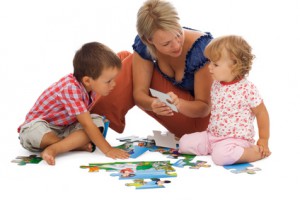Mom: Buffering…Buffering
Sadly, our children witness many traumatic events. They may see them in person, on their screens, in the news…. It’s hard to protect them from everything that is going on around us. But a study published in Stress and Health suggests that parents (mothers in this study) play an important role in helping children learn to manage stress and trauma. How? Mothers help their children regulate reactions and organize their emotions. Consider this simple example. A young child is startled by a stranger knocking on the door. The mother notices her child’s reaction and concern. She calmly explains what is happening: “Someone knocked on our door. I wonder who it is?” She then picks her young child up and walks toward the door. By her calm reaction and description of the situation, an appropriate response of curiosity, and casual offer of physical comfort, she has demonstrated a sensitivity to her child’s reaction and responded to her child’s needs. She has been responsive in light of the situation at hand. She has provided a sense of security for her child.
This is a relatively benign situation. Some situations, however, have the potential to arouse the mother’s anxiety and stress as well. In fact, this study was completed with mothers and children living in an area of armed conflict between people groups. In such situations, the mother has to delay her own impulsive reaction, not get caught up in her own worries and anxieties. It becomes important for a mother to learn to manage her own emotions, fears, and impulses as well.
By responding in a calm, responsive, and contingent manner, a mother coregulates her child’s emotions and helps her child learn how to regulate their own emotions independently. Let’s review this process:
- The mother manages her own impulsive reaction. She does not get caught up in her own worries and anxieties but calms her anxieties and fears so she can comfort her child. She will benefit from having close friends or adult family members to help her process all her emotions following any event. The mother benefits from processing life’s stresses and traumas with another adult, not her children.
- Setting aside her own impulsive reaction, the mother then communicates information to her child that will explain the situation and any necessary course of action.
- During each step, the mother remains aware of her child’s needs and responds accordingly. Do they need a hug? Do they simply need reassurance? Are they able to understand directives given? She remains sensitive to her child’s needs and responds to meet whatever needs arise—a hug, a smile, gentle guidance, reassurance, etc.
Fred Rogers (Mr. Rogers) said that “anything human is mentionable and anything mentionable can be more manageable. When we talk about our feelings, they become less overwhelming, less upsetting, and less scary. The people we trust with that important talk can help us know that we are not alone.” In this case, a mother’s ability to communicate important information plays a role in effectively responding to her child in stressful, even traumatic moments, and so strengthens her child’s resilience.

-0 Comment-